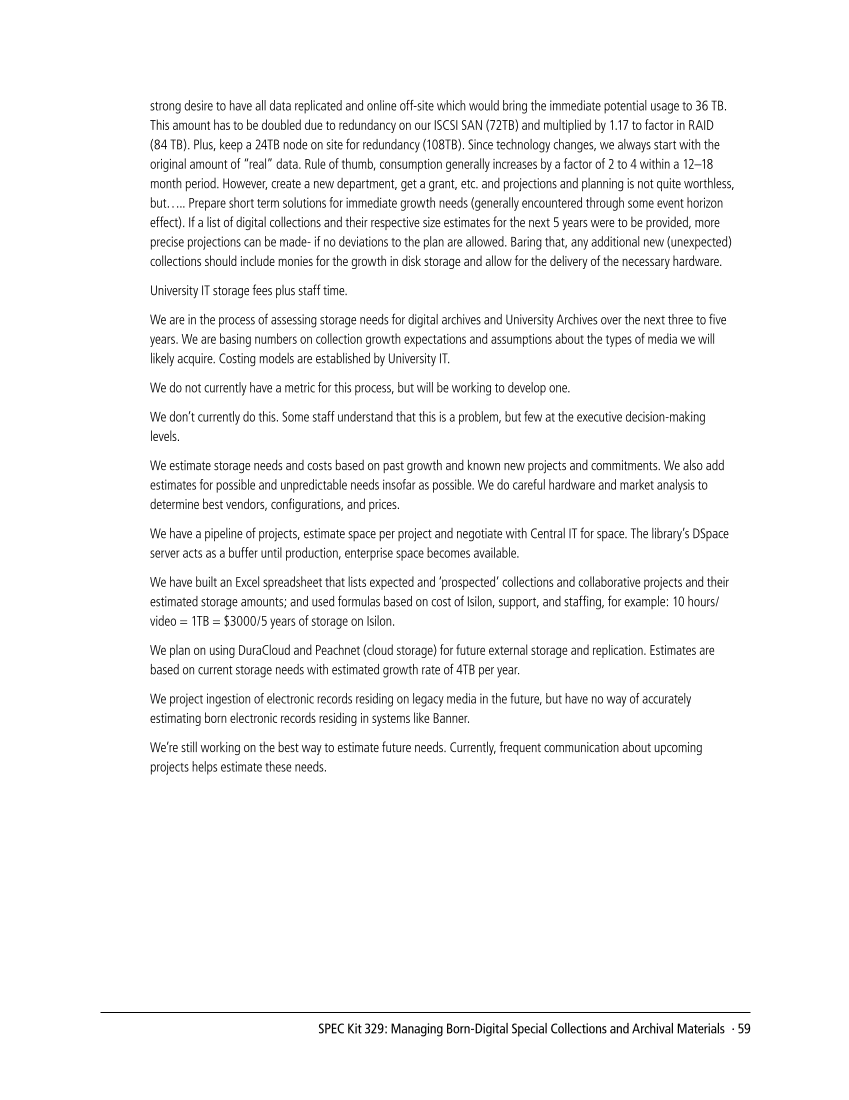SPEC Kit 329: Managing Born-Digital Special Collections and Archival Materials · 59
strong desire to have all data replicated and online off-site which would bring the immediate potential usage to 36 TB.
This amount has to be doubled due to redundancy on our ISCSI SAN (72TB) and multiplied by 1.17 to factor in RAID
(84 TB). Plus, keep a 24TB node on site for redundancy (108TB). Since technology changes, we always start with the
original amount of “real” data. Rule of thumb, consumption generally increases by a factor of 2 to 4 within a 12–18
month period. However, create a new department, get a grant, etc. and projections and planning is not quite worthless,
but….. Prepare short term solutions for immediate growth needs (generally encountered through some event horizon
effect). If a list of digital collections and their respective size estimates for the next 5 years were to be provided, more
precise projections can be made- if no deviations to the plan are allowed. Baring that, any additional new (unexpected)
collections should include monies for the growth in disk storage and allow for the delivery of the necessary hardware.
University IT storage fees plus staff time.
We are in the process of assessing storage needs for digital archives and University Archives over the next three to five
years. We are basing numbers on collection growth expectations and assumptions about the types of media we will
likely acquire. Costing models are established by University IT.
We do not currently have a metric for this process, but will be working to develop one.
We don’t currently do this. Some staff understand that this is a problem, but few at the executive decision-making
levels.
We estimate storage needs and costs based on past growth and known new projects and commitments. We also add
estimates for possible and unpredictable needs insofar as possible. We do careful hardware and market analysis to
determine best vendors, configurations, and prices.
We have a pipeline of projects, estimate space per project and negotiate with Central IT for space. The library’s DSpace
server acts as a buffer until production, enterprise space becomes available.
We have built an Excel spreadsheet that lists expected and ‘prospected’ collections and collaborative projects and their
estimated storage amounts and used formulas based on cost of Isilon, support, and staffing, for example: 10 hours/
video =1TB =$3000/5 years of storage on Isilon.
We plan on using DuraCloud and Peachnet (cloud storage) for future external storage and replication. Estimates are
based on current storage needs with estimated growth rate of 4TB per year.
We project ingestion of electronic records residing on legacy media in the future, but have no way of accurately
estimating born electronic records residing in systems like Banner.
We’re still working on the best way to estimate future needs. Currently, frequent communication about upcoming
projects helps estimate these needs.
strong desire to have all data replicated and online off-site which would bring the immediate potential usage to 36 TB.
This amount has to be doubled due to redundancy on our ISCSI SAN (72TB) and multiplied by 1.17 to factor in RAID
(84 TB). Plus, keep a 24TB node on site for redundancy (108TB). Since technology changes, we always start with the
original amount of “real” data. Rule of thumb, consumption generally increases by a factor of 2 to 4 within a 12–18
month period. However, create a new department, get a grant, etc. and projections and planning is not quite worthless,
but….. Prepare short term solutions for immediate growth needs (generally encountered through some event horizon
effect). If a list of digital collections and their respective size estimates for the next 5 years were to be provided, more
precise projections can be made- if no deviations to the plan are allowed. Baring that, any additional new (unexpected)
collections should include monies for the growth in disk storage and allow for the delivery of the necessary hardware.
University IT storage fees plus staff time.
We are in the process of assessing storage needs for digital archives and University Archives over the next three to five
years. We are basing numbers on collection growth expectations and assumptions about the types of media we will
likely acquire. Costing models are established by University IT.
We do not currently have a metric for this process, but will be working to develop one.
We don’t currently do this. Some staff understand that this is a problem, but few at the executive decision-making
levels.
We estimate storage needs and costs based on past growth and known new projects and commitments. We also add
estimates for possible and unpredictable needs insofar as possible. We do careful hardware and market analysis to
determine best vendors, configurations, and prices.
We have a pipeline of projects, estimate space per project and negotiate with Central IT for space. The library’s DSpace
server acts as a buffer until production, enterprise space becomes available.
We have built an Excel spreadsheet that lists expected and ‘prospected’ collections and collaborative projects and their
estimated storage amounts and used formulas based on cost of Isilon, support, and staffing, for example: 10 hours/
video =1TB =$3000/5 years of storage on Isilon.
We plan on using DuraCloud and Peachnet (cloud storage) for future external storage and replication. Estimates are
based on current storage needs with estimated growth rate of 4TB per year.
We project ingestion of electronic records residing on legacy media in the future, but have no way of accurately
estimating born electronic records residing in systems like Banner.
We’re still working on the best way to estimate future needs. Currently, frequent communication about upcoming
projects helps estimate these needs.










































































































































































































